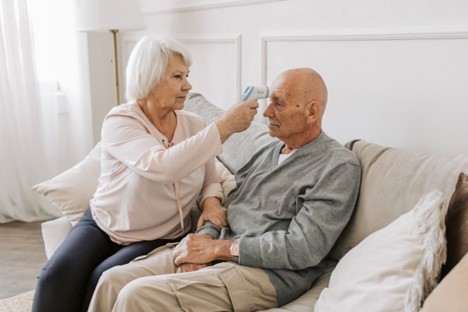Aging in place is becoming increasingly popular among seniors who want to maintain their independence while staying in the comfort of their own homes.
Yet as we grow older, our mobility and physical capabilities change,meaning we need to adapt our homes early on to make sure we can age in place safely.
So how do you do that? In this post, we’ll walk you through some simple modifications you can make – ones that don’t have to break the budget, but can make a world of difference when it comes to staying at home for your golden years.
Entryways That Welcome You In
Think of your home’s entryway as the first hurdle to overcome in making sure your home is ready for aging in place – it’s best tackled with a bit of preparation. The goal here is to ensure easy access and safety.
Install Ramps or Stairlifts
If stairs are involved in getting into your home, consider installing a ramp or stairlift. These modifications can make entry and exit easier and safer, especially for those using walkers or wheelchairs.
Widen Doorways
Standard doorways often fall short of accommodating walkers or wheelchairs. Widening doorways can make daily navigation less of a hassle and more of a breeze.
Add Non-Slip Mats and Handrails
Ensure that all entry points are equipped with non-slip mats to prevent slips and falls. Handrails offer extra support and stability, turning a potentially tricky threshold into a manageable one.
Living Room Layouts for Easy Navigation
The living room is where we relax, entertain, and, let’s admit it, nap. Making it senior-friendly is essential, but fortunately, quite easy.
Rearrange Furniture
Make sure there’s ample space for easy movement by rearranging furniture. Avoid clutter and keep pathways clear.
Enhance Lighting
Adequate lighting can prevent trips and falls in the living room as well as all the other areas of the home. Swap out dim bulbs for brighter, energy-efficient options. Consider adding floor lamps or wall-mounted lights to illuminate dark corners.
Kitchen Comfort and Accessibility
The kitchen is often the heart of the home, but it can become a challenge as we age. Here’s how to keep it senior-friendly.
Lower Countertops and Cabinets
Consider lowering countertops and cabinets to make them more accessible. This change minimizes the need for awkward stretching or dangerous climbing.
Install Pull-Out Shelves and Drawers
Pull-out shelves and drawers can make reaching for items easier and safer. No more straining to grab that elusive spice jar at the back.
Use Lever-Style Handles
Replace standard knobs with lever-style handles for faucets and doors. These are easier to grip and require less force, making everyday tasks simpler.
Bathrooms Built for Safety
Bathrooms can be hazardous, but with a few tweaks, they can become safe sanctuaries.
Install Grab Bars
Grab bars in the shower and near the toilet provide extra support and can prevent falls. They’re a simple addition that offers significant peace of mind.
Use Non-Slip Flooring and Mats
Non-slip mats in the shower and non-slip flooring throughout the bathroom are must-haves. They reduce the risk of slipping on wet surfaces.
Accessible Storage
Make sure all towels, toiletries, and other essentials are within easy reach. Wall-mounted storage can keep everything at hand without cluttering counters.
Bedroom Bliss
Your bedroom should be an oasis of comfort and safety. Here’s how to do it:
Nightlights or Motion-Sensor Lights
Place nightlights or motion-sensor lights to illuminate the path to the bathroom. These small lights can prevent nighttime falls.
Daily Essentials Within Reach
Keep daily essentials like medications, water, and books within easy reach. Bedside organizers can help keep everything in order.
Tech That Makes Life Easier
Technology isn’t just for the younger generation. Smart home devices can significantly enhance safety and convenience for seniors as can some of the following options:
- Voice Activated Devices: Voice-activated devices like Alexa or Google Assistant can control lights, thermostats, and even call for help in emergencies. They’re the ultimate in hands-free convenience.
- Fall Detection Systems: Fall detection systems can alert emergency services or family members if a fall occurs. These systems offer an extra layer of security.
- Automatic Lighting: Automatic lighting systems can ensure that you’re never left fumbling in the dark. Lights that turn on and off based on movement or time can be incredibly useful.
- Medication Reminders: Smart medication reminders can help make sure that you never miss a dose. These gadgets can remind you to take your meds at the right time, every time.
Wrapping It Up
Adjusting your home for aging in place doesn’t have to be daunting. By making thoughtful changes to entryways, living rooms, kitchens, bathrooms, and bedrooms, and by integrating smart technology, you can create a safe and comfortable environment that allows you to live independently for years to come.
Remember, it’s not about dramatic overhauls but rather clever adjustments that make life easier and safer. Whether you’re a senior, a caregiver, or a homeowner preparing for the future, these tips will help you create a welcoming, senior-friendly home.
Ready to make your home the ultimate aging-in-place sanctuary? Start with these practical steps, and you’ll be well on your way to a safer, more comfortable living space.

